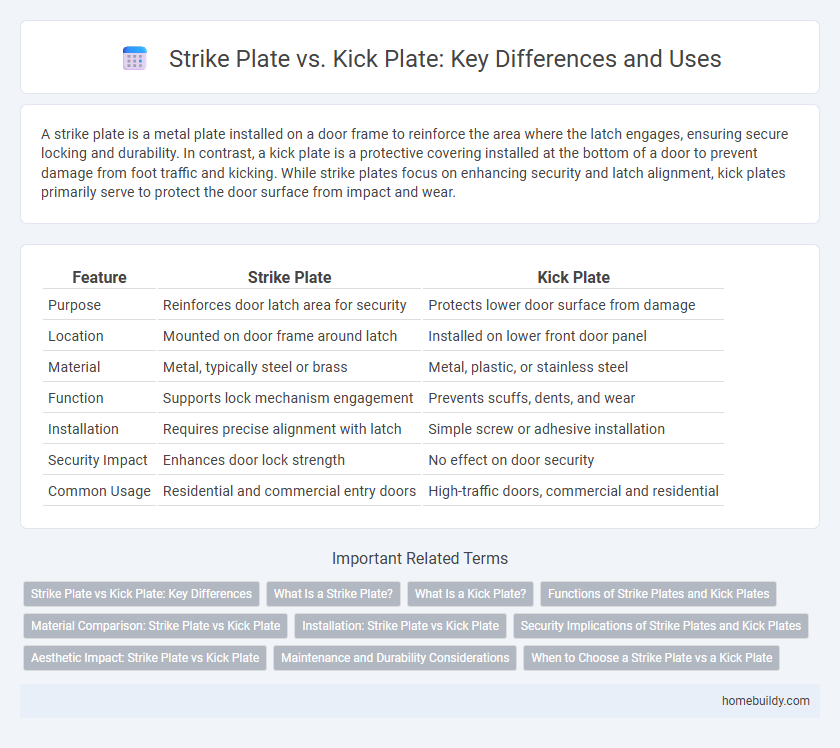A strike plate is a metal plate installed on a door frame to reinforce the area where the latch engages, ensuring secure locking and durability. In contrast, a kick plate is a protective covering installed at the bottom of a door to prevent damage from foot traffic and kicking. While strike plates focus on enhancing security and latch alignment, kick plates primarily serve to protect the door surface from impact and wear.
Table of Comparison
| Feature | Strike Plate | Kick Plate |
|---|---|---|
| Purpose | Reinforces door latch area for security | Protects lower door surface from damage |
| Location | Mounted on door frame around latch | Installed on lower front door panel |
| Material | Metal, typically steel or brass | Metal, plastic, or stainless steel |
| Function | Supports lock mechanism engagement | Prevents scuffs, dents, and wear |
| Installation | Requires precise alignment with latch | Simple screw or adhesive installation |
| Security Impact | Enhances door lock strength | No effect on door security |
| Common Usage | Residential and commercial entry doors | High-traffic doors, commercial and residential |
Strike Plate vs Kick Plate: Key Differences
Strike plates and kick plates serve distinct functions in door hardware; a strike plate is a metal plate affixed to a door frame that reinforces the latch or bolt area, ensuring secure locking and alignment. In contrast, a kick plate is installed at the lower portion of a door to protect it from damage caused by foot traffic, kicks, or scuffs. Understanding the key differences helps in selecting the right hardware for enhanced door durability and security.
What Is a Strike Plate?
A strike plate is a metal plate installed on door frames to reinforce the latch or bolt's contact point, ensuring secure closure and preventing door frame damage. It differs from a kick plate, which primarily protects the lower part of the door from scuffs and impact. Strike plates are essential for door security and function, while kick plates focus on durability and aesthetic protection.
What Is a Kick Plate?
A kick plate is a protective metal or plastic sheet installed on the lower portion of a door to prevent damage from foot traffic, carts, or equipment. Unlike a strike plate, which reinforces the door jamb around the latch or bolt for secure locking, a kick plate absorbs impact and wear at the bottom of the door. Kick plates are commonly used in high-traffic areas to extend the life and appearance of doors.
Functions of Strike Plates and Kick Plates
Strike plates reinforce door frames by securing the latch and deadbolt mechanisms, enhancing security and ensuring proper door closure. Kick plates protect the lower portion of doors from damage caused by foot traffic, carts, and equipment, thereby extending door longevity. Both components serve essential functions in maintaining door integrity, with strike plates focused on locking performance and kick plates on physical durability.
Material Comparison: Strike Plate vs Kick Plate
Strike plates are typically made from durable metals such as stainless steel, brass, or zinc alloy to withstand repeated door latching forces, providing security and longevity. Kick plates, often crafted from stainless steel, aluminum, or brass, are designed primarily to protect door surfaces from damage caused by foot traffic, emphasizing impact resistance over structural strength. The material choice for strike plates focuses on mechanical durability for locking mechanisms, while kick plates prioritize surface protection and aesthetic resilience.
Installation: Strike Plate vs Kick Plate
Strike plate installation involves securing a metal plate to the door frame to reinforce the latch area and ensure proper alignment with the door lock, typically requiring precise chisel work to fit flush. Kick plate installation differs by attaching a larger metal plate at the bottom of the door using screws or adhesive, primarily serving to protect against foot damage and usually demands less precise fitting. Both installations require different tools and expertise, with strike plates emphasizing lock functionality and kick plates focusing on door durability.
Security Implications of Strike Plates and Kick Plates
Strike plates enhance door security by reinforcing the latch area and distributing force during forced entry attempts, reducing the risk of frame damage. Kick plates primarily protect the lower door surface from physical impact and wear without significantly improving resistance to break-ins. Installing a heavy-duty strike plate with long screws into the door frame substantially improves security compared to using only a kick plate.
Aesthetic Impact: Strike Plate vs Kick Plate
Strike plates and kick plates serve distinct aesthetic roles in door hardware, with strike plates typically offering a minimalistic and subtle appearance, blending seamlessly with door locks and frames. Kick plates, often larger and more visible, add a decorative layer while providing protection against scuffs and wear, thereby enhancing both functionality and visual appeal. Selecting between the two depends on the desired balance between discreet hardware integration and bold protective accents in interior or exterior design.
Maintenance and Durability Considerations
Strike plates require regular inspection for alignment and wear to maintain door security and functionality, as misalignment can cause door latch issues. Kick plates, often made of durable metals like stainless steel or brass, primarily protect lower door surfaces from scuffs and impacts, reducing aesthetic damage but usually demand less frequent maintenance. Both plates enhance door longevity; strike plates focus on mechanical durability, while kick plates offer protective reinforcement against physical damage.
When to Choose a Strike Plate vs a Kick Plate
Choose a strike plate when your primary concern is reinforcing the door frame around the latch or deadbolt to improve security and ensure proper alignment for locking mechanisms. Opt for a kick plate when the objective is to protect the lower portion of the door from scuffs, dents, and damage caused by foot traffic or equipment. Strike plates enhance locking strength and security, while kick plates focus on preserving door appearance and structural integrity in high-traffic areas.
strike plate vs kick plate Infographic

 homebuildy.com
homebuildy.com